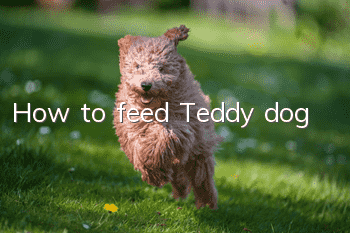How to feed Teddy dog

How to feed a Teddy dog? Puppies are weaned about 6 weeks after birth. After weaning, they are fed regularly and quantitatively at fixed points every day. The food should be reasonably matched; the first vaccine shot is given 40 days ago, a total of 4 shots, and once a year after becoming an adult dog. Acupuncture, in addition to deworming work; exercise for about 20 to 40 minutes every day, and use your free time to train some basic movements.
【Diet management of puppies】
The growth period from puppy to adult is very important. It can influence the puppy's life and affect the quality of the poodle.
Puppies are weaned about 6 weeks after birth.
From weaning to about the third month, feeding times should be set at 7 a.m., 12 noon, 5 p.m. and 10 p.m. 4 times a day.
From the 4th month to the 8th month after birth, puppies can be fed three times in the morning, noon, and evening. The amount of food given to puppies during this period is approximately equivalent to 1/3-1/ of adult dogs. 2.
In the months from 2 to 3 months to within 6 months after weaning, the puppy’s food composition will determine its lifelong eating habits. If you plan to continue raising your dog with specialized dog food in the future, you must allow it to adapt to the taste of specialized dog food during this period of time.
If they are raised with family meals, the food should be mainly animal protein and feed more high-calorie foods.
When puppies are 2 to 3 months old, since their teeth and jaws are not yet fully developed, meat should be cut into fine pieces before feeding them. Butter, cheese, etc. are also suitable.
The period from 6 months to 1 year old is approximately equivalent to a human being in his teens. This period is the period when Poodles grow most vigorously, and the calories they need are about twice as much as those of adult dogs! They should be fed more animal protein foods.
【Must read on puppy diet and feeding】
1. Food suitable for puppies
(1) Food specifically for puppies: such as dog food and canned food.
(2) Calcium: Supplement calcium products with high natural content, such as super calcium, to promote bone and tooth development of puppies.
(3) Milk powder for puppies: There is special goat milk powder for puppies.
(4) Egg yolk: The advantage of egg yolk is that it is not only rich in protein, but also contains vitamin A, calcium and minerals that are easy to digest and absorb.
(5) Vitamins and minerals: For puppies with poor physical fitness, consider supplementing some additional vitamins and minerals. You can consider feeding 21 Gold Vitamin, and there is also puppy Gold Vitamin specially designed for pets.
(6) Meat: Although beef, pigs, chicken, etc. are excellent foods, when feeding puppies, you should choose fat-free parts because fat is easy to deteriorate. But feed cooked meat, not raw meat!
2. Food not suitable for puppies
(1)Frozen milk
(2) Contains a large amount ofFatty meat.
(3) Sour, spicy, salty and other irritating foods.
(4) Small bones: Large and medium-sized puppies can be fed large bones rich in calcium. Never feed chicken, fish, duck bones, etc.
(5) Pastries Generally speaking, there is no need to feed dogs cakes.
(6) Do not feed chicken livers, poultry offal, etc.
(7)Chocolate
【Vaccines and deworming】
The first shot of vaccine is given in 40 days, and then every 15 days, plus the rabies vaccine, a total of 4 shots are given. The first time you take the infectious vaccine, you need to take three shots and then add one shot of rabies vaccine, and then the infectious vaccine. It is a shot once a year, and the rabies vaccine is a shot every three years.
Teddy dogs also need to be dewormed internally. When getting vaccinated, the dog must ensure good health. Poor health of the Teddy dog will reduce the immunity of the Golden Retriever and affect the health. Teddy dogs can only go out to play one week after being vaccinated.
【Common diseases and prevention and treatment】
The focus on disease prevention for poodles is regular vaccination.
You should pay attention to the dog's health at ordinary times, and you can do a quick check when combing the dog's coat every day. Check the dog's body from head to toe for signs of illness, such as swelling, abnormal secretions, abnormal body temperature or pulse, lack of energy, etc. Once the problem is discovered, prevent and treat it immediately, so that your dog can be completely cured in the early stages of the disease.
Frequently occurring abnormal symptoms
Experienced breeders can detect the dog’s disease in time based on some common symptoms and provide timely treatment to ensure the healthy growth of the dog. Poodles may exhibit the following symptoms when they are sick.
Strange steps: First of all, you should think about whether there are foreign objects stuck in the soles of its feet, whether it is injured, whether there are fleas between its toes, etc. If no obvious trauma is found, it may be due to pain caused by arthritis that affects walking, or rickets or bone dysplasia. Touch its feet. If it screams, it may be broken or dislocated.
No appetite: If you have no appetite but are still in good spirits, you can observe for another 1-2 days. However, if you have no appetite and are accompanied by obvious weight loss, you should pay attention. If the food intake is less than half of the usual amount and the dog is lying still, you should take it to the hospital for examination. This condition can basically detect other diseases and should be observed carefully.
Drinking more water: Dogs drink more water after walking to regulate their body temperature. If they drink a lot of water without much activity, you should first consider whether the dog has eaten food with too much salt. In addition, high fever, dysentery, diabetes, kidney disease, diabetes insipidus, etc. are all reasons why dogs drink a lot of water. If the cause cannot be found, a veterinarian should be consulted for diagnosis and treatment.
Odor: Poodles themselves have no body odor. If they emit a smell, you should pay attention to it. Possible odor in the mouthIt is caused by calculus or stomatitis; ear odor is caused by otitis externa, otitis media or ear ulcers; body hair odor should be considered due to skin inflammation or anal cyst; genital odor is caused by uterine inflammation, genital ulcers and urinary secretion Abnormalities and other reasons. Once you find the cause of the odor, you should see a veterinarian.
Cough: Frequent coughing indicates abnormalities in the dog’s respiratory organs and bronchi. If a cold is not diagnosed and treated in time, it may also cause bronchitis or pneumonia. If your cough is severe, you most likely have asthma. If a foreign body is inhaled, it will be very painful to cough. When you have infectious bronchitis and you also have a cough, please seek medical treatment as soon as possible.
Dry nose: It is normal for a dog to have a dry nose when he first wakes up, but be careful if he also has a fever at the same time. In addition, symptoms such as runny nose, nosebleeds, nasal swelling, and blocked nostrils should not be ignored. The causes of these symptoms may be rhinitis caused by colds, as well as head trauma, abscesses, ulcers, vitamin A deficiency, nutritional deficiencies, etc.
Salivation in the mouth: You should check whether you have stomatitis, whether the mouth is punctured by foreign objects such as bone tips, sawdust, etc., whether the color of the tooth roots changes (such as white, yellow, excessively red, black, etc.), and whether there are other traumas.
Frequent vomiting: If the dog's spirit improves after vomiting, it is not a serious problem. If the dog vomits repeatedly or becomes limp and weak, something may be wrong. Possible causes include: foreign body blockage in the esophagus, swallowing of indigestible items such as plastic bags, intestinal obstruction or volvulus, Balboa virus infection, leptospirosis or other diseases. At this time, the owner should bring the dog's vomit to a doctor for diagnosis and treatment.
Eye circles full of eye feces: If you find that the dog’s eye circles are full of eye feces, or the eyes are swollen and other symptoms, you should consult a doctor. You must not use human eye medicine to treat the dog on your own.
If there is a red blood vessel-like object in the white part of the eyeball: use eye drops to observe carefully, and use Runkang eye drops to instill it. If it does not increase in size, leave it alone.
Adult poodles are susceptible to otitis externa (miniature adult teddy dogs are more susceptible)
Cause: Otitis externa is caused by the accumulation and deterioration of earwax, which irritates the skin of the external auditory canal and causes repeated bacterial infection of the earwax.
Symptoms: The sick dog is itchy and shakes its head frequently. If it continues to develop, it will cause pain. Therefore, it resists contact with its ears and surrounding areas. A foul-smelling yellow-brown pus can be found flowing out. If not treated immediately, the inflammation can spread to the middle or inner ear, damaging the eardrum and ultimately causing hearing loss.
Prevention: Regular examination and cleaning of the ear canal is essential, and it is recommended to do so once every two weeks.
Tracheal atrophy (miniature and toy types are susceptible)
Cause: The trachea is originally tubular, but when the annular ligament stretches and the tracheal cartilage can no longer maintain its normal state, tracheal atrophy will occur
Symptoms: Frequent coughing, difficulty breathing, and gradual resistance to exercise. Occurs after exercise, excitement, eating, and drinking.Dry cough, the cough lasts for about 15 minutes, and the cough attacks include walking around in circles or sitting still.
Prevention: Prevent excitement, control weight, use a harness instead of a collar, and do not use medication casually.
Gastric volvulus (standard type prone)
Cause: Gastric dilation occurs after eating a large amount, and the ligaments supporting the stomach stretch. Sudden vigorous exercise at this time can easily cause gastric torsion.
Symptoms: difficulty breathing, abdominal pain, sudden vomiting, and excessive salivation.
Note: If gastric torsion is not treated immediately, death will occur within 24 hours.
【Sports and training】
It is enough to let the Teddy dog exercise or walk for about 20 to 40 minutes every day. You can also use this time to train it some basic or more difficult movements to consume the Teddy dog's strong energy. People with high IQs can learn any kind of dog faster than other dogs. Their sensitive and alert learning ability will be seen during retraining.
The purpose of training a toy dog is, first, to make it develop good eating and hygiene habits to facilitate feeding and management; second, to make it capable of doing a few cute little tricks to bring fun to the dog owner and family. The training subjects are simple and easy to do.
【The specific nursing methods are as follows:】
1: You should start brushing your teddy bear’s teeth 2-3 times a week when he is 6 months old.
At first, little Teddy will be uncomfortable and resist, but if he persists, he will develop better habits. First, dip a gauze strip into a little saline and wrap it around your index finger, then wipe the gums and between the teeth in sequence, using gentle movements to avoid damaging the gums. After the poodle adapts, dip a little pet toothpaste into it and brush its teeth. This toothpaste does not require rinsing. mouth, allowing it to dry up on its own. The above operation can last for 2 weeks. After it is fully adapted, use a special toothbrush for dogs to brush its teeth. After long-term persistence, you can get the ideal nursing effect.
Two: Don’t give your little Teddy too much sweets, such as chocolate and sugar, to prevent him from developing dental caries. You can feed it various chewing bones such as vegetable sticks, which can not only exercise the bite force of the little teddy bear's teeth, but also play a role in cleaning tartar and tartar.
Three: If oral ulcers, red and swollen gums, etc. occur, you can use warm saline to clean them and apply iodine glycerin or antibiotics. If the lesions are serious, apply antibiotic therapy.
Four: Often supplement some vitamin B complex drugs or puppy gold vitamins to supplement vitamins and trace elements to reduce the incidence of disease.
Tips: Doing daily preventive work can greatly reduce the number of times your dog gets sick.
【Grooming】
It is better to comb their fur at least once or more times a week. Although they will not shed (provided their skin is healthy), they must be combed and tidied frequently, otherwise their fluffy and curly fur will become The knots will look very sloppy, but you can comb them when you think of it, and they will be very happy! ExceptIn addition to helping them promote hair metabolism, it is also a good way to promote the relationship between owners and pets. For beauty and hair trimming, a major haircut can be done about once every 2 months.
【Summer hair care matters】
Every summer is the peak period for dog teddy bear skin diseases. The following methods can be used to prevent it.
A dog’s hair is divided into two parts: inner and outer. The inner hair is downy for warmth, and the outer hair is steel wool for waterproofing and windproofing. The fluff will fall off naturally after a certain period of time, so human help is needed. The fluff is easily knotted and if it is not combed for a long time, it will stick to the dog's skin like a cake. It will also hinder the growth of new fluff and prevent air circulation. High skin temperature gives some parasites and fungi room to live, so it is best to comb the dog's hair every day, starting from the skin stem and combing outwards. After bathing, be sure to rinse, blow dry and comb the hair. Dogs should be sprayed with anti-flea and fungus medicine regularly every month. The medicine should be sprayed on the skin and gently massaged with hands twice a month. This can reduce the risk of skin diseases. The grass outside can also spread fleas and fungi. Please be careful when passing by.
After bathing, you should use cotton to clean the inside of the ears to prevent ear mites and ear infections. Dogs do not have sweat glands, and the soles of their feet are the way for them to dissipate heat. You should trim the fur on your dog's feet regularly to prevent the puppy from slipping. You won’t fall down all the time. There is a blood vessel in the dog’s toenail that will grow together with the toenail. Therefore, when the dog is young, the toenails must be trimmed regularly to prevent the toenails from becoming too long and difficult to trim.
- How to calculate the age of a golden retriever dog
- How to judge the quality of Pomeranian dogs
- How to care for poodle hair
- How Teddy Dog Ends
- How to bathe a Samoyed puppy
- What to do if Teddy is particularly clingy
- How to make Samoyed recognize its owner
- What should I do if my Chihuahua has a lot of eye mucus?
- How to keep a Samoyed from shedding
- How to Deworm a Poodle



